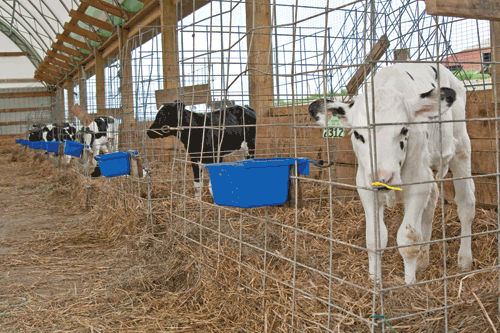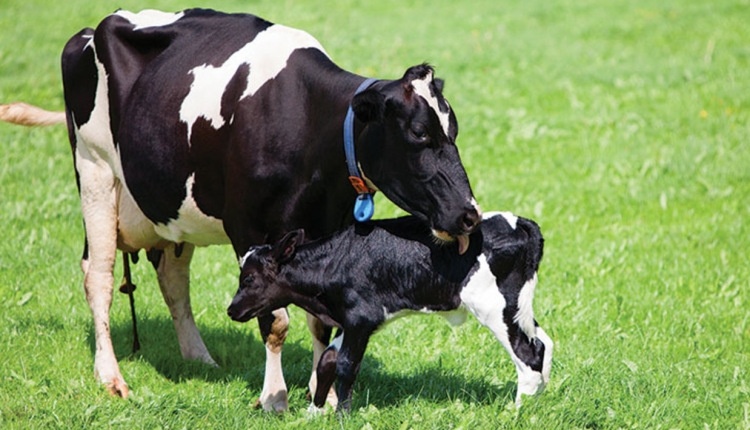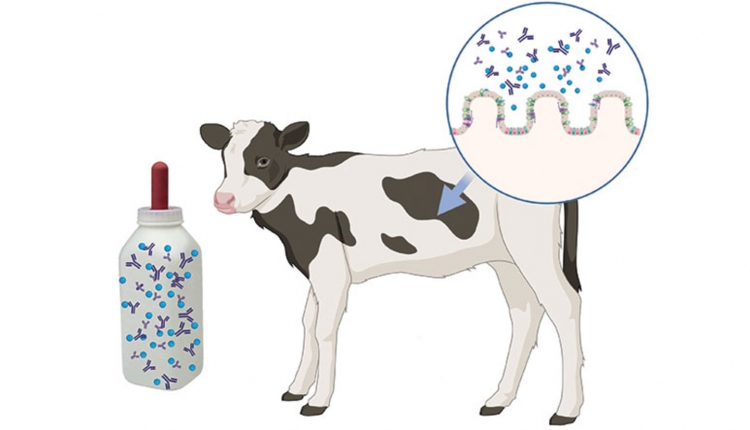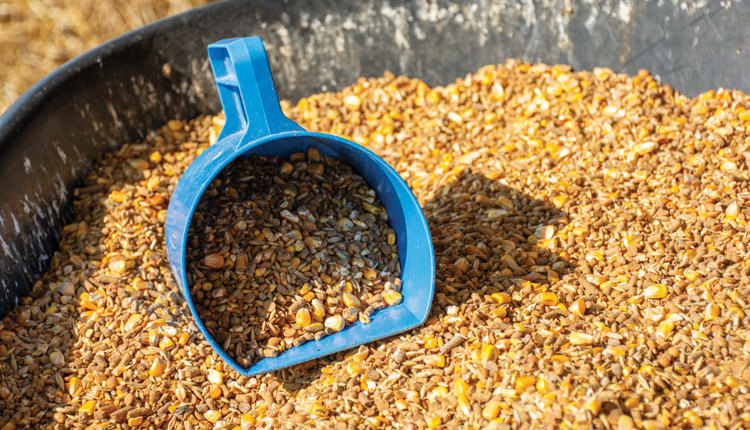The author is the principal in Andhil, LLC, a St. Louis-based consulting firm.

Calves should be eating a pound of starter a day the week before weaning. Then keep them in individual pens or hutches for another two weeks as starter intake climbs to about 5 to 6 pounds before calves are moved into groups.
In a previous column, "Don't drop the ball when you wean calves," (May 10, 2007, issue, page 340), emphasis was on feeding and management aspects of calf starters. But that is only one aspect of the calf-raising situation. We still see too many problems with calves after weaning.
Calves are the most vulnerable and sensitive animals on a dairy. Yet, they are subjected to conditions and situations that, by comparison, we would not think of subjecting our own young children or babies to. Both young calves and babies do not like changes in schedule or environment.
People calendar wean
According to the 2007 National Animal Health Monitoring System (NAHMS), the average (and most popular) age at weaning in the U.S. is 8 weeks. With the exception of 7 weeks of age, the other most popular ages at weaning are 6, 10, or 12 weeks. Why are the most popular ages of weaning even-numbered weeks? It is for the benefit of whatever management scheme is being followed, not for a particular need of calves.
From a nutritional perspective, the amount and composition of the liquid feed largely provides for meeting the calf's protein and energy needs. These, in turn, control how much the calf grows with ambient temperature and housing conditions playing a role. In colder weather, you must make adjustments in order to continue projected/targeted daily gains. ("Keep calves gaining during cold weather," November 2008 issue, page 719.)
While the milk or replacer feeds the calf's monogastric digestive system, the calf needs to shift toward becoming a functional ruminant. The key to that is consumption of the grain-based starter which empties into the immature and initially nonfunctional rumen. The best starter is one in texturized form which stimulates rumen development through its larger particles. This causes more cud chewing, saliva production, and favorable rumen volatile fatty acid (VFA) production (see May 10, 2007, issue, page 340).
You should not feed hay before weaning. It fills up the rumen due to its slower rate and extent of digestion, and it doesn't produce the right balance of VFA production for rumen development and function. (In fact, hay should not be fed for two to four weeks after weaning). Also, starter intake will not be as good if you don't have clean water available. Calves need to drink four times as much water as their dry feed intake.
Keep calves in individual hutches or stalls for two weeks after weaning. This will reduce some stress, encourage more starter intake and rumen development, and make it less tempting to start feeding hay or silage before they can utilize forages.
Why setbacks occur
Too often, people move calves into a large group pen with other calves right after they are weaned and feed them a TMR that may contain 50 percent forage. Suddenly, they have to establish a "pecking order" within the group, learn how to drink water and eat feed from new sources, and be more exposed to the environment, in most cases. Other changes that often occur at weaning are vaccinations, dehorning, and even tail docking.
What happens when the period after weaning is too stressful? Calves' immunity drops, and they have a respiratory outbreak. This requires various treatments with considerable cost, often with heroic effort to save the calf.
Once the calf appears to be back to normal, you usually forget that the calf was ever treated. But is that calf really okay? Before weaning, the main cause of death is scours. After weaning, it is respiratory problems, according to the 2007 NAHMS report. But it is the "living dead" with respiratory problems that are the major concern. These calves often are affected for life.
Long-term records from a New York state study in 1995 found that these "respiratory-affected" calves had higher mortality before calving, were less likely to enter the milking herd, took longer to grow before first calving, and had more calving problems. ("Calves go through a transition at weaning," June 2003 issue, page 436). However, since few people record calf treatments for respiratory problems and track progress of those calves, they will not recognize this problematic relationship. If they did, they would be better off economically, in most cases, in culling calves that had respiratory problems when young rather than feed and care for them one to two years. They would realize that it required more time and more costs to raise that heifer into the milking string.
What you can do
Recommendations are:
• Have a good transition leading up to weaning. Be sure that calves are averaging at least 1 pound daily of starter intake for the week before you cut milk/replacer feeding in half by eliminating one of two daily feedings. When one of those feedings is eliminated, daily starter intake should double that week to 2 pounds. If calves are kept in the individual hutch or stall for two more weeks, you should see starter intake double to 4 pounds and then to 5 to 6 pounds over those two weeks. When starter intake is too low going into weaning, calves will not be able to avoid a slump after weaning.
• If you can accomplish the above routine, consider weaning at 6 weeks rather than at 8. Six weeks was the second most common age at weaning next to 8 weeks, according to the 2007 NAHMS report. Benefits to this include not needing more hutches or stalls to keep calves for an additional two weeks of starter feeding after weaning, giving calves more time for more functional development of the rumen before hay is fed, and one less change to subject calves to when they are moved to the first grouping.
• Use a texturized calf starter. Sure it costs more, but the calves benefit more in rumen development and intake.(See May 10, 2007, issue, page 340.) Then continue feeding the starter in the first grouping, limiting it to 6 to 8 pounds per calf daily. Do not feed a TMR to this first group pen. One pound of alfalfa or a good-quality grass hay is about all the forage they can handle well at this stage/age. Sure, they will eat a 50 percent forage TMR, but look at the rumen fill on these heifers. If you sacrificed some of them, you would notice this and less rumen papillae development.
• Provide clean water so that feed intake is not limited. Remember that 4 to 1 ratio of water to feed. When calves still are in hutches or stalls, have a divider between water and starter containers. Otherwise, calves will dribble feed into water and water into feed. That will reduce intake of both.
• Keep the first group pens small so that establishing the pecking order is not as traumatic and prolonged. Some farms use super-hutches for this purpose with as few as six to eight calves. This will make it easier to avoid feeding a 50 percent forage TMR at this stage.
• Last, don't get hung up on cutting costs at this stage. It will limit your being able to foster a good start in the most vulnerable and efficient nutrient converter on a dairy. Trying to save $25 to $50 per calf versus an overall cost of $1,200 to $1,500 to raise a heifer can truly be penny-wise but pound foolish.
Click here to return to the Calf & Heifer E-Sources 100125_58

Calves should be eating a pound of starter a day the week before weaning. Then keep them in individual pens or hutches for another two weeks as starter intake climbs to about 5 to 6 pounds before calves are moved into groups.
In a previous column, "Don't drop the ball when you wean calves," (May 10, 2007, issue, page 340), emphasis was on feeding and management aspects of calf starters. But that is only one aspect of the calf-raising situation. We still see too many problems with calves after weaning.
Calves are the most vulnerable and sensitive animals on a dairy. Yet, they are subjected to conditions and situations that, by comparison, we would not think of subjecting our own young children or babies to. Both young calves and babies do not like changes in schedule or environment.
People calendar wean
According to the 2007 National Animal Health Monitoring System (NAHMS), the average (and most popular) age at weaning in the U.S. is 8 weeks. With the exception of 7 weeks of age, the other most popular ages at weaning are 6, 10, or 12 weeks. Why are the most popular ages of weaning even-numbered weeks? It is for the benefit of whatever management scheme is being followed, not for a particular need of calves.
From a nutritional perspective, the amount and composition of the liquid feed largely provides for meeting the calf's protein and energy needs. These, in turn, control how much the calf grows with ambient temperature and housing conditions playing a role. In colder weather, you must make adjustments in order to continue projected/targeted daily gains. ("Keep calves gaining during cold weather," November 2008 issue, page 719.)
While the milk or replacer feeds the calf's monogastric digestive system, the calf needs to shift toward becoming a functional ruminant. The key to that is consumption of the grain-based starter which empties into the immature and initially nonfunctional rumen. The best starter is one in texturized form which stimulates rumen development through its larger particles. This causes more cud chewing, saliva production, and favorable rumen volatile fatty acid (VFA) production (see May 10, 2007, issue, page 340).
You should not feed hay before weaning. It fills up the rumen due to its slower rate and extent of digestion, and it doesn't produce the right balance of VFA production for rumen development and function. (In fact, hay should not be fed for two to four weeks after weaning). Also, starter intake will not be as good if you don't have clean water available. Calves need to drink four times as much water as their dry feed intake.
Keep calves in individual hutches or stalls for two weeks after weaning. This will reduce some stress, encourage more starter intake and rumen development, and make it less tempting to start feeding hay or silage before they can utilize forages.
Why setbacks occur
Too often, people move calves into a large group pen with other calves right after they are weaned and feed them a TMR that may contain 50 percent forage. Suddenly, they have to establish a "pecking order" within the group, learn how to drink water and eat feed from new sources, and be more exposed to the environment, in most cases. Other changes that often occur at weaning are vaccinations, dehorning, and even tail docking.
What happens when the period after weaning is too stressful? Calves' immunity drops, and they have a respiratory outbreak. This requires various treatments with considerable cost, often with heroic effort to save the calf.
Once the calf appears to be back to normal, you usually forget that the calf was ever treated. But is that calf really okay? Before weaning, the main cause of death is scours. After weaning, it is respiratory problems, according to the 2007 NAHMS report. But it is the "living dead" with respiratory problems that are the major concern. These calves often are affected for life.
Long-term records from a New York state study in 1995 found that these "respiratory-affected" calves had higher mortality before calving, were less likely to enter the milking herd, took longer to grow before first calving, and had more calving problems. ("Calves go through a transition at weaning," June 2003 issue, page 436). However, since few people record calf treatments for respiratory problems and track progress of those calves, they will not recognize this problematic relationship. If they did, they would be better off economically, in most cases, in culling calves that had respiratory problems when young rather than feed and care for them one to two years. They would realize that it required more time and more costs to raise that heifer into the milking string.
What you can do
Recommendations are:
• Have a good transition leading up to weaning. Be sure that calves are averaging at least 1 pound daily of starter intake for the week before you cut milk/replacer feeding in half by eliminating one of two daily feedings. When one of those feedings is eliminated, daily starter intake should double that week to 2 pounds. If calves are kept in the individual hutch or stall for two more weeks, you should see starter intake double to 4 pounds and then to 5 to 6 pounds over those two weeks. When starter intake is too low going into weaning, calves will not be able to avoid a slump after weaning.
• If you can accomplish the above routine, consider weaning at 6 weeks rather than at 8. Six weeks was the second most common age at weaning next to 8 weeks, according to the 2007 NAHMS report. Benefits to this include not needing more hutches or stalls to keep calves for an additional two weeks of starter feeding after weaning, giving calves more time for more functional development of the rumen before hay is fed, and one less change to subject calves to when they are moved to the first grouping.
• Use a texturized calf starter. Sure it costs more, but the calves benefit more in rumen development and intake.(See May 10, 2007, issue, page 340.) Then continue feeding the starter in the first grouping, limiting it to 6 to 8 pounds per calf daily. Do not feed a TMR to this first group pen. One pound of alfalfa or a good-quality grass hay is about all the forage they can handle well at this stage/age. Sure, they will eat a 50 percent forage TMR, but look at the rumen fill on these heifers. If you sacrificed some of them, you would notice this and less rumen papillae development.
• Provide clean water so that feed intake is not limited. Remember that 4 to 1 ratio of water to feed. When calves still are in hutches or stalls, have a divider between water and starter containers. Otherwise, calves will dribble feed into water and water into feed. That will reduce intake of both.
• Keep the first group pens small so that establishing the pecking order is not as traumatic and prolonged. Some farms use super-hutches for this purpose with as few as six to eight calves. This will make it easier to avoid feeding a 50 percent forage TMR at this stage.
• Last, don't get hung up on cutting costs at this stage. It will limit your being able to foster a good start in the most vulnerable and efficient nutrient converter on a dairy. Trying to save $25 to $50 per calf versus an overall cost of $1,200 to $1,500 to raise a heifer can truly be penny-wise but pound foolish.











